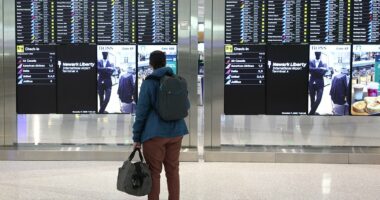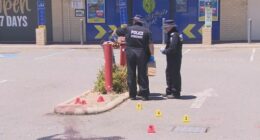Share this @internewscast.com
Australians are bracing for intense weather conditions as New South Wales faces scorching heat, while parts of Victoria and South Australia are preparing for cyclone-strength winds.
An intense hot air mass, which originated over the Pilbara and shattered October temperature records in the Outback, is now moving eastward toward Sydney.
Sydney’s western suburbs could reach temperatures in the low 40s on Wednesday, with relief expected as cooler weather arrives by Thursday.
Simultaneously, Victoria and South Australia are on high alert for severe winds and storm conditions, as two powerful weather systems converge off the southern coast.
Senior meteorologist Angus Hines from the Bureau of Meteorology forecasts a “blistering” high of 39°C for Sydney as the heatwave advances east. Surrounding metro areas are also expected to experience temperatures in the high 30s to low 40s.
The peak in temperatures is anticipated to occur mid-afternoon.
‘It’s certainly not out of the question that parts of the city could flirt with 40 degrees today, and we will be very near record temperatures around the Sydney area for this time of year,’ he said.
‘It will be hot right along there east coast.
‘There’s also a 39C forecast temperature for Gosford and Newcastle as well as further south for Wollongong, 37C as the high down there.’

Ravaging heat is expected to pass eastwards towards Sydney today, bringing a maximum temperature of 39C and potentially higher in metro suburbs

A hot mass of air moving across the country will hit Sydney on Wednesday, with high winds and storm conditions predicted
Meanwhile, severe weather warnings are in place across Victoria and South Australia on Wednesday, with destructive winds above 125km/g are expected on exposed coastal sites.
Residents have been warn to prepare for risks of falling trees, power outages and property damage as the brutal winds bear down on the coast.
Winds are expected to pick up near the Victoria and South Australia border on Wednesday morning before drifting eastwards in the early afternoon.
The combined cold front and rapidly building low-pressure system will charge east throughout the day, bringing dangerous gusts across Victoria, southeastern SA and the NSW coast and ranges.
The brutal heat expected in Sydney follows days of record-breaking temperatures further inland, as the oppressive heat system makes its way east.
Inland towns across the state’s north-west broke October records on Tuesday, including Tibooburra and Cobar which both soared past 42C, breaking new highs set only the day before.
The heat is also gripping the tablelands and western slopes, where temperatures are running 12 to 15C above average for this time of year.
Weatherzone meteorologist Ben Domensino expects the average NSW temperature to hit 27.1C this month, five degrees above normal levels.

Sydneysiders have been urged to stay hydrated and avoid strenuous activities amid the searing heat

Fire bans are in place across much of NSW including Sydney as the state braces for soaring temperatures, bringing increased risk of bushfires
Further north, inland Queensland will cool slightly but remain hot, while the state’s southeast is expected to swelter through its hottest day on Thursday.
Total fire bans are in place across much of NSW including Sydney and the Illawarra and Hunter regions as the searing conditions bringing increased risk of bushfires.
NSW Rural Fire Service Commissioner Trent Curtin said high fire danger was expected over the course of the day.
‘Today we’re going to see very high temperatures in the high 30s and possible low 40s across parts of NSW, combined with very strong winds that will be in the 40[km/h] range,’ he told ABC’s News Breakfast.
He added isolated gusts could reach 60 to 80km/h in parts of those areas.
‘We’ll see high fire danger across most of the state but extreme fire conditions across parts of the state.’
The Bureau has urged residents to stay hydrated, avoid strenuous outdoor activity and monitor weather warnings.
Warnings are also available through TV and radio broadcasts, the Bureau’s website at www.bom.gov.au or via phone at 1300 659 210.
















